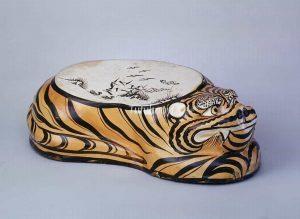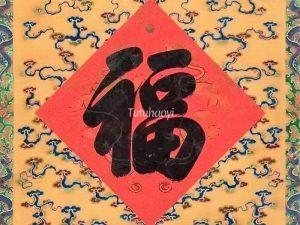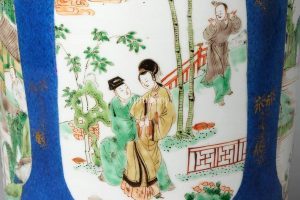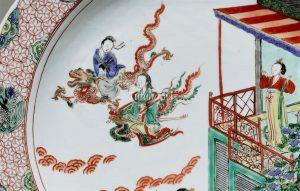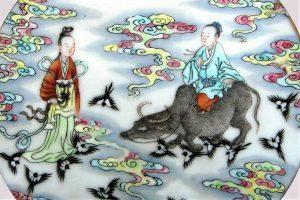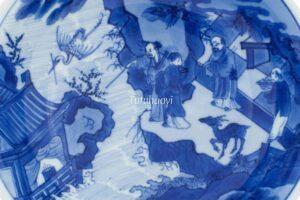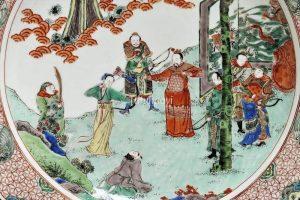Blogs
Interesting findings & case studies on commonly misunderstood and mystery images
2022 is the year of Tiger according to Chinese lunar calendar. Dr Yibin Ni has conducted a research overview of the pictorial representation of the tiger in the background of Chinese culture and history, from the origin of its motif in relics to various artistic forms in traditional decorative arts over the past three thousand years.
‘福 fu’, a Chinese character bearing an auspicious meaning of ‘good fortune’, has been used often in Chinese decorative arts. Dr Yibin Ni will tell you some interesting stories related to this character and how the intended meaning is represented in various art forms.
The story scene comes from a marvel play Legend of the Jade Hairpin, which is not to be confused with the scene in Romance of the Western Chamber. Read the following article to find out details of the story and how this figural scene is depicted.
Chinese people deeply respect the elderly and traditionally consider a long existence to be one of the most important blessings in a person’s life. Here are many examples of how artists have combined a variety of longevity symbols to reinforce the potency of this concept.
In Chinese culture, the Mid-Autumn Moon Festival is related to the legendary fairy Chang E, the Moon Goddess. We often see a hare, her loyal companion, and an osmanthus tree in the picture with her against a background of the Moon Palace. However, why does Chang E often hold an osmanthus sprig, and what does she have to do with scholars attending civil-service examinations? Let’s invite Dr Yibin Ni to explain to you with his interesting literary research findings.
Appreciation of a top-tier porcelain garlic-head bottle vase painted with a pair of red-whiskered bulbuls in polychrome enamels over transparent glaze in the falangcai style and gilding displayed in the Petite Galerie of the Louvre in Paris.
Correctly identifying figures is crucial to deciphering an obscure story scene. Looking at this featured image, for example, some may think that the two figures in non-specific attires on a dragon and a phoenix are anonymous Daoist immortals. But Dr Yibin Ni would tell you the story otherwise…
On the seventh day of the seventh month of the lunar Chinese year, young men and women will celebrate their traditional ‘Valentine’s Day’, Qixi Festival (七夕节). The custom can be traced back to an ancient story.
More often than not, traditional Chinese motifs or symbols are not receiving their deserved attention, being given simplistic or inadequate labels and inaccurate explanations in our museums, catalogues, or even scholarly writing. The treatment of many pictorial representations of the thousand-year-old literary anecdote ‘A bamboo counter is being added to the house in the sea (海屋添筹 hai wu tian chou)’ is a case in point.
Congratulations on art historian Dr Yibin Ni’s new research into a rare story scene in Chinese pictorial art, which may have puzzled contemporary museum curators and porcelain collectors. Dr Ni has traced the art historical context in which this rare pictorial scene of The Wife of the Bow Maker in the State of Jin was created and provided us with historical evidence to identify and illuminate its unique composition. His work on this previously mysterious story scene has undoubtedly contributed to the treasure trove of Chinese iconography.
CATEGORIES
RECENT POSTS
 October 03, 2022The ‘Double Yang Day’ in Chinese Traditional Festivals
October 03, 2022The ‘Double Yang Day’ in Chinese Traditional Festivals July 20, 2022Pictorial Presentations of the Story of Cowherd and the Weav ...
July 20, 2022Pictorial Presentations of the Story of Cowherd and the Weav ... June 25, 2022Pictorial Presentation of Amitabha and the Two Assistant Bod ...
June 25, 2022Pictorial Presentation of Amitabha and the Two Assistant Bod ... May 16, 2022Hongwu Porcelain – The Treasure in Ming Dynasty Founded by Z ...
May 16, 2022Hongwu Porcelain – The Treasure in Ming Dynasty Founded by Z ... April 09, 2022How did Guo Ziyi deter the colossal enemy army without fight ...
April 09, 2022How did Guo Ziyi deter the colossal enemy army without fight ...
Archives
- October 2022
- July 2022
- June 2022
- May 2022
- April 2022
- March 2022
- February 2022
- January 2022
- December 2021
- November 2021
- October 2021
- September 2021
- August 2021
- July 2021
- June 2021
- May 2021
- April 2021
- March 2021
- February 2021
- January 2021
- December 2020
- November 2020
- October 2020
- September 2020
- August 2020
- July 2020
- June 2020
- May 2020
- April 2020
